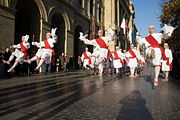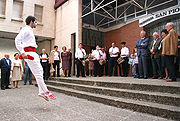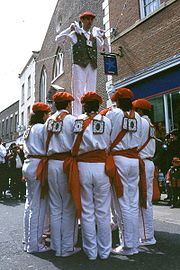
Basque dance
Encyclopedia

Folk dance
The term folk dance describes dances that share some or all of the following attributes:*They are dances performed at social functions by people with little or no professional training, often to traditional music or music based on traditional music....
by Basque people
Basque people
The Basques as an ethnic group, primarily inhabit an area traditionally known as the Basque Country , a region that is located around the western end of the Pyrenees on the coast of the Bay of Biscay and straddles parts of north-central Spain and south-western France.The Basques are known in the...
of Basque Country ,
History

Basque Country (historical territory)
The Basque Country is the name given to the home of the Basque people in the western Pyrenees that spans the border between France and Spain on the Atlantic coast....
to another the music, steps and costumes change, but the collective reveals the Basques’
Basque people
The Basques as an ethnic group, primarily inhabit an area traditionally known as the Basque Country , a region that is located around the western end of the Pyrenees on the coast of the Bay of Biscay and straddles parts of north-central Spain and south-western France.The Basques are known in the...
deep love of dance. There are approximately 400 distinct Basque folk dances, each with its own story and significance. Some, the more ancient ritual dances, are performed only for particular events or circumstances and initially were performed by male dancers only. Many include the use of sticks and swords that the dancers strike together as they progress through the movements of the dance. The more recent social dances derive from early celebratory dances but are today devoid of any sacred function. They are characterized by differences in style and function, and allow for dual-gender participation. Some are more complex, while others are simpler. Some are ritual while others are entertaining. Some sacred and other profane. Some are open group dances and others closed. Generally the space in which they are carried out is open, although a few were originally danced in closed quarters. The vast majority are danced only by men, some only by women and others by both sexes. The basic characteristics of Basque dance are seen in the choreography, historical and festive elements, and the universal traits of tradition, entertainment, tourism and especially religious-festive events. You can tell a good dancer by how high they jump, their double clicks, how high they kick, and their gracefulness.
^This is not history this is a description^
Early observations
Voltaire noted in his observations-
- "The basque, this people who sings and dances on his mountains"
Strabo's observation in the first century B.C.
-
- "(Basques) danced after drinking, alone or in groups, competing...as to who should leap the highest and fall on his knees with the most grace"
Types of dance
Dantzari Dantza from DurangaldeaDurangaldea
Durangaldea is a comarca of Biscay located in the Basque Country, Spain. It is one of the seven comarcas or regions that compose the province of Biscay. The capital city of Durangaldea is Durango.- Geography :...
(Biscay) is a well known cycle of dances where on the eve of the local feast day, it is the custom to set up the traditional San Juan
San Juan, Puerto Rico
San Juan , officially Municipio de la Ciudad Capital San Juan Bautista , is the capital and most populous municipality in Puerto Rico, an unincorporated territory of the United States. As of the 2010 census, it had a population of 395,326 making it the 46th-largest city under the jurisdiction of...
or Donianeatxa oak tree
Oak Tree
Oak Tree may refer to:*Oak, the tree*Oak Tree, County Durham, a village in County Durham, England*The Oaktree Foundation, a youth-run aid and development agency*Oak Tree National, golf club in Edmond, Oklahoma...
(now usually a poplar). The trunk is peeled and the branches limbed, and flowers and a sometime a flag or two are placed at the top. All of the festive activities take place around this symbol, which is set up in the middle of the town square. The nine dances that make up the cycle have remained unchanged since at least the 19th century; the choreography consists of two parallel rows of dancers standing face to face. The dancers, in a show of virility, very skillfully manoeuvre fighting weapons as part of the dance.
Sorgin Dantza from Oria
Oria
-Places:Italy* Oria, Apulia, a town in the Apulia region, Province of Brindisi* Oria, Lombardy, a village in the municipality of Valsolda, in the Province of ComoSpain* Oria, Spain, a municipality in the Province of Almería, Andalusia...
(Gipuzkoa) is a comical or a burlesque dance that reach their peak in the Sorgin
Sorginak
Sorginak are the assistants of the goddess Mari in Basque mythology. It is also the Basque name for witches or pagan priestesses , being difficult to discern between the mythological and real ones.Sometimes sorginak are confused with lamiak...
Dantza, or dance of the witches. These dances, a combination of wild and sometimes a bit obscene body movements, have managed to remain alive over time in certain towns. The best known of these dances can be seen in the town of Lasarte-Oria
Lasarte-Oria
Lasarte-Oria is a town located in the province of Gipuzkoa, in the Autonomous Community of Basque Country, northern Spain.-External links:* Information available in Spanish and Basque.* Information available in Spanish...
. As the story goes, this dance simulates a group of workers who moved here from the town of Bergara
Bergara
Bergara is a town located in the province of Gipuzkoa, in the autonomous community of Basque Country, in the north of Spain.An Enlightened center of education operated by the Real Sociedad Bascongada de Amigos del País , it was the place where Faustino Elhuyar discovered wolfram.During the Carlist...
. Today this dance is also danced in the town of Antzuola
Antzuola
Antzuola is a town located in the province of Gipuzkoa, in the Autonomous Community of Basque Country, northern Spain.-External links:* *...
during Carnival, although here, along with the dantzaris and musicians, there are also people dressed up as bears and monkeys.
Mutxikoak is a popular dance of Basque Ancestors, which comes back stronger these days, as if the tradition could never been forgotten. Mutxikoak which in Basque means that at first "a young boy’s dance", although women dance it more now than young boys. It is danced in circle as around a sun, where the individuality of each other fuse together with the universality of an illimited circle, where each person is unique even if everybody dances the same dance.
Weapon dances

Weapon dance
The weapon dance employs weapons—or stylized versions of weapons—traditionally used in combat in order to simulate, recall, or reenact combat or the moves of combat in the form of dance, usually for some ceremonial purpose. Such dancing is quite common to folk ritual in many parts of the world...
.
The ezpatadantza ("sword dance") comes from the Durango area and is danced for authorities and in the feast of Corpus Christi
Corpus Christi (feast)
Corpus Christi is a Latin Rite solemnity, now designated the solemnity of The Most Holy Body and Blood of Christ . It is also celebrated in some Anglican, Lutheran and Old Catholic Churches. Like Trinity Sunday and the Solemnity of Christ the King, it does not commemorate a particular event in...
.
After the dance, both opposing rows of dancers raise their weapons and form a corridor for the authorities.
The ezpatadantza and the makildantza ("stick
Makila
The makila is a traditional Basque walking stick, and is notable as both a practical tool and a cultural symbol of authority and strength.-Etymology:...
dance") ends with the dancers raising one of them, lying as a fallen warrior, over their heads.
In the Basque
Basque Country (autonomous community)
The Basque Country is an autonomous community of northern Spain. It includes the Basque provinces of Álava, Biscay and Gipuzkoa, also called Historical Territories....
province of Gipuzkoa in Spain, the Okrabario Dantza is performed in Legazpi
Legazpi, Spain
Legazpi is a city in the Gipuzkoa province of the Autonomous Community of Basque Country, northern Spain.Legazpi is a town of about 9000 inhabitants located on top of Urola valley, in Guipuzcoa...
—a sword dance in which a participant dances atop a grid of crossed swords held aloft. In Tolosa
Tolosa, Spain
Tolosa is a town and municipality to the south of Donostia-San Sebastián in the Basque province of Gipuzkoa, Spain. It is located in a valley of the river Oria and overlooked by Uzturre, a white cross-topped mountain.-Famous people from Tolosa:...
, on Midsummer Day, the Bordon-Dantza ("walking stick
Makila
The makila is a traditional Basque walking stick, and is notable as both a practical tool and a cultural symbol of authority and strength.-Etymology:...
dance") is performed with the figures of the ezpatadantza; some point its origins to the border fights in the Middle Ages, when the Castilian troops from Gipuzkoa won an important victory over the troops from Navarre
Navarre
Navarre , officially the Chartered Community of Navarre is an autonomous community in northern Spain, bordering the Basque Country, La Rioja, and Aragon in Spain and Aquitaine in France...
at the Battle of Beotibar
Beotibar
Beotibar is a Spanish locality near Tolosa in the Gipuzkoa province of northern Spain, in the northeastern part of the autonomous community of the Basque Country...
. Sticks simulate some weapons, and halberd
Halberd
A halberd is a two-handed pole weapon that came to prominent use during the 14th and 15th centuries. Possibly the word halberd comes from the German words Halm , and Barte - in modern-day German, the weapon is called Hellebarde. The halberd consists of an axe blade topped with a spike mounted on...
s--a combination of a spear and a battle-axe—are also used.

